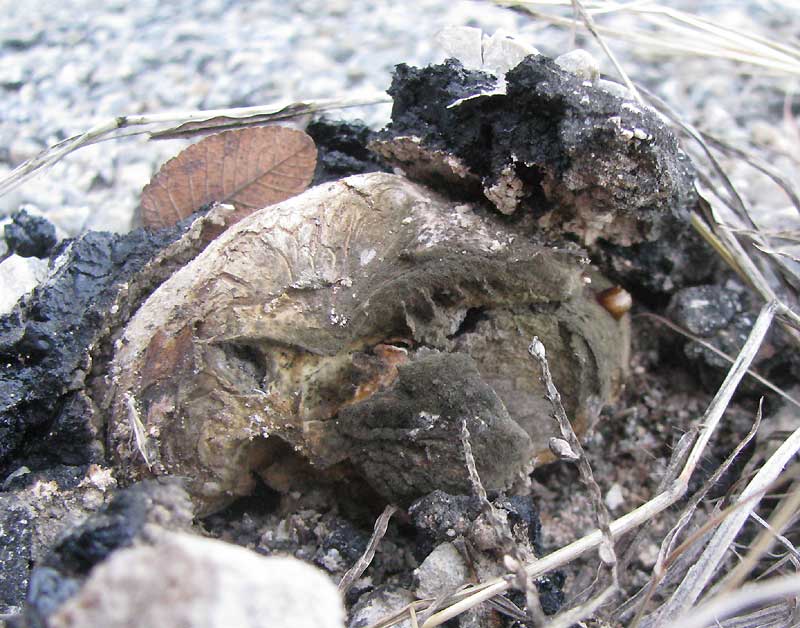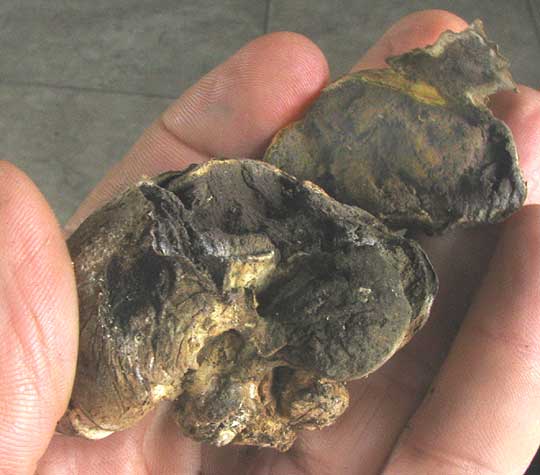Excerpts from Jim Conrad's
Naturalist Newsletter

from the January 6, 2013 Newsletter issued from the valley of the Dry Frio River in northern Uvalde County, southwestern Texas, on the southern border of the Edwards Plateau; elevation ~1750m (~5750 ft); N29.62°, W99.86°; USA
POTATO EARTHBALL
During the dusk walk, at the thin edge of the asphalt road, something egg-sized was pushing up from beneath the pavement causing the asphalt to buckle and crack. I lifted away a loose asphalt plate and exposed what you can see above.
It was a kind of puffball mushroom, about the homeliest looking one you could imagine, looking like a dirty, smooth-skinned, malformed potato cracking open here and there. However, you can see that the pavement it was pushing up was a good half inch thick (2.5cm), so you have to give the little being credit for its strength and persistence.
The working fungus body, the network of hyphae gathering water and nutrients, was in the ground below and alongside the road, so I felt little guilt about plucking the little puffball for study, for it was nothing but the fungus's ephemeral reproductive structure. The ball was mature and full of spores, and I figured that after I'd studied it, on a windy day I'd crumble the spore-filled interior and toss it into the wind, helping the spores disseminate into new territory much more effectively than if the puffball were to stay there mostly covered by asphalt.
At home I broke off one corner of the puffball to see what the spongy, spore-filled interior looked like. You can what I saw below:

In that picture the knobby protuberance at the puffball's bottom is the rudimentary stem, which in this species doesn't develop much more than you see here. The puffball's white skin covers a dry, spongy mass called the gleba. Millions of spores are suspended in the gleba. Though one description I find of this species say that its gleba is black, and another says it's deep purple-brown, you can see that our mushroom's gleba is dark brown.
This mushroom is SCLERODERMA BOVISTA, often called the Potato Earthball. It's widespread in Europe and North America. You don't eat this potato because it's poisonous, causing severe problems in the gastrointestinal system.
Reading that Potato Earthball spores have an unusual appearance, I looked at them under the microscope, and you can see them yourself below:

The fuzzy, round items are the spores, and the fuzz, or spines as they're called in the literature, are part of what makes the spores unusual. You can barely make out the other unusual feature on a few spores, which is that the spore surface is reticulated, a little like the windowed surface of a honeycomb. The spores are about 13 microns across -- 0.013mm, or 0.0005 of an inch.
"Puffball" and "earthball" are both informal terms without technical distinctions. Some would say that the Potato Earthball is not a puffball. Generally, puffballs are more lightweight and softer, while earthballs are heaver and harder. The Potato Earthball doesn't puff out its spores through openings in the skin, but rather fractures irregularly so that its spores get distributed rather haphazardly.